CASE 2: CAUSES AND CONSEQUENCES OF EXTINCTION
Despite the fact that humans have accelerated the rate of extinction for hundreds of years, the idea that species loss constitutes an environmental crisis has only recently gained widespread attention. For example, although at least 571 species of plants have gone extinct in the wild since 1750 (according to global surveys recently published in Nature Ecology & Evolution), scientists have only begun concerted efforts to save these possibly invaluable species in the last half-century. Today, discussions surrounding extinction focus on the physical impacts of 7 billion people’s large footprint upon the planet - from deforestation in the Amazon Rainforest due to the need for more agricultural lands, to severe bushfires in Australia aggravated by copious combustion of fossil fuels. However, the historical roots of our current problems developed long ago and, although understanding them could help us address our current crisis, they’ve received comparably little press coverage. In this part of the exhibit, we use historical examples of how deliberate overexploitation, a focus on high-productivity, and a strong desire to “tame” wilderness, steeped in ideological notions of colonialism, led to local extinction or the near destruction of many species - from the plains bison to the Bald Eagle. Long before the Earth felt the strain of ~ 7.5 billion humans, our impact on the world's oceans, grasslands, and forests was disproportionately large compared to our population size due to these common sociocultural norms. Today, I hope these books provide windows into the prevailing norms of the past, demonstrating how our beliefs can guide our actions - for good or for bad - and hence how large of an impact we have on the environment.
Aside from showcasing the root causes of species extinction, these historical examples offer valuable lessons of what is at stake when a species is lost. Many of us agree that nature has an intrinsic value in and of itself or is valuable to protect because destruction of life is morally wrong. However, there exist many other tangible examples of values that are lost when a species goes extinct. For example, the disappearance of species previously used to satisfy some human requirement, want, or need (e.g., whales being hunted for their oil, which was used to light lamps and stoves) , has led to a considerable loss of use value. The loss of species that have high use value forces us to find alternative, and likely costlier, means of satisfying human needs and wants (e.g., extraction of fossil fuels like petroleum and natural gas or to run lamps, stoves and engines). Likewise, the historical extirpation of whales and other animals imbued with spiritual significance and/or used to support customs, beliefs, and especially indigenous ways of living and transmission of cultural knowledge - such as plains bison or walrus - has also led to a significant loss in cultural value. The loss of culturally valuable species makes it challenging for communities to maintain their traditions, sovereignty, sustainable practices and sense of community. Losing culturally valuable species also frequently exacerbates the large negative impacts still felt by indigenous communities from the legacy of colonialism; since many rely upon diverse and native plant and animal species to nourish healthy diets and communal relations, and even Native languages. As Inuit activist and scholar Sheila-Watt Cloutier remarks:
"Nowhere else in the world does ice and snow, and the animals that rely upon it, represent transportation, mobility, and life for peoples. Ice and snow are our highways that bring us to the supermarket, which is the environment and links us to each other (and other communities). Several communities already as we speak are so damaged by global warming and climate change, and with it the loss of traditional foods, that relocation at the cost of millions of dollars is now the only option."
In the lived epxeriences of Cloutier and many other indigenous and rural community members around the world, species loss exacerbated by globalization and global warming is one of the ugly faces of modern colonialism.
Furthermore, given how interconnected species are within their respective ecosystems, the loss of any given species can also have an unexpected domino effect upon other linked species, leading to a loss of environmental value. For example, the loss of the famous passenger pigeon from America’s forests has now been linked to increased numbers of rodents and hence Lyme-disease-carrying ticks, which in turn negatively impact human health on the scale of billions of dollars each year. By extirpating an insatiable seed-gobbling bird that once numbered in the billions, we effectively lost the environmental value these birds provided in suppressing rodent populations and, in turn, Lyme disease. With a reduction in environmental value, other organisms who depend on proper functioning of the ecosystem (which includes humans) may suffer.
Similarly, whenever an animal or plant goes extinct, the loss of genetic diversity reduces the options available to future generations when we face problems such as disease or drought. Stated alternatively, reducing genetic diversity diminishes bequest value, or, the value a current generation places on ensuring the availability of biodiversity and ecosystem functioning to future generations. For example, as we lose varieties or species of plants that possess medicinal properties or are more resistant to certain diseases, future generations will have less options in combating pathogens threatening ourselves or our food supply. Examples of lost bequest value abound in our historical records, including here in the Northeastern United States where the number of apple varieties has been reduced by over 75%, from an estimated 17,000 in the mid-1800s to 4,000 today. The culprit? A growing and unquenchable desire for larger, cheaper, more uniform apples has led farmers to abandon heirloom verities in favor of a smaller number of apple types suitable for industrial production.
Overall, the loss of any given species - even unsightly insects or snakes - brings with it the loss of multiple values that directly or indirectly affect our ability, or the ability of other organisms, to persist and live comfortably on planet earth. The most troubling aspect of current trends in extinction is that species are disappearing so rapidly that scientists don’t have time to fully understand what might be at stake until it’s too late. Like the disappearance of passenger pigeons from America’s skylines, it sometimes takes nearly a hundred years for the negative effects to be felt and quantified, and sometimes the ramifications are not what might be expected.
Case 2 Items : Causes & Consequences
-
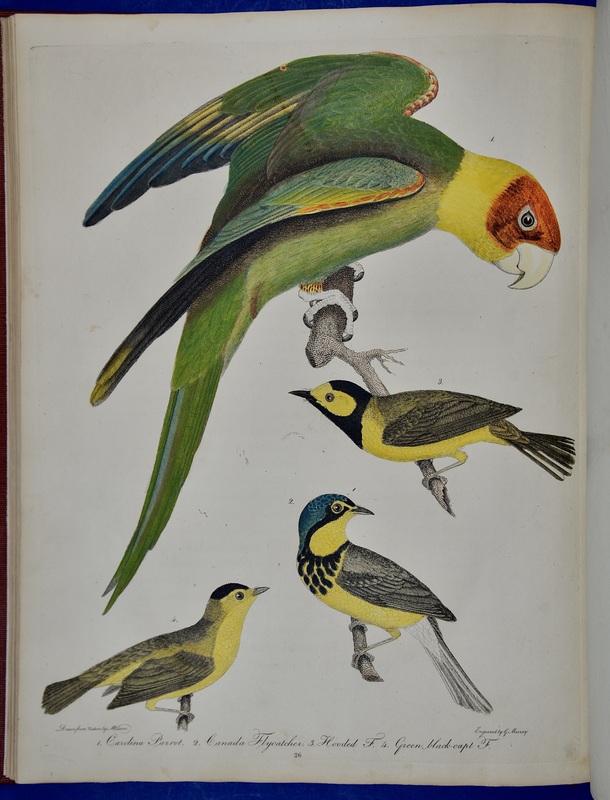 American Ornithology Alexander Wilson writes fondly of the Carolina Parakeet, America’s only parrot species, but he also discusses how they were a considerable nuisance to farmers. Their appetites lent them to being “destroyed in great numbers, for whilst busily engaged in plucking off the fruits or tearing the grain from the stacks, the husbandman approaches them with perfect ease, and commits great slaughter among them.” To make matters worse, the forests in which these birds lived were cleared in large swaths and their colorful feathers became popular decorations for women’s hats. The last Carolina Parakeet died in captivity at the Cincinnati Zoo in 1918. Aside from their bygone charms, Carolina Parakeets were important seed dispersers, meaning their disappearance negatively affected various seed-bearing plants.
American Ornithology Alexander Wilson writes fondly of the Carolina Parakeet, America’s only parrot species, but he also discusses how they were a considerable nuisance to farmers. Their appetites lent them to being “destroyed in great numbers, for whilst busily engaged in plucking off the fruits or tearing the grain from the stacks, the husbandman approaches them with perfect ease, and commits great slaughter among them.” To make matters worse, the forests in which these birds lived were cleared in large swaths and their colorful feathers became popular decorations for women’s hats. The last Carolina Parakeet died in captivity at the Cincinnati Zoo in 1918. Aside from their bygone charms, Carolina Parakeets were important seed dispersers, meaning their disappearance negatively affected various seed-bearing plants. -
 Photographs of American Elms at Dartmouth College These photographs depict the large stands of American Elm trees that once towered above Dartmouth’s campus as well as their removal in the 1950s and 1960s when the trees began dying following the accidental introduction of Dutch Elm Disease (DED). Prior to the introduction of DED, American Elm trees were so plentiful around Hanover that Dartmouth was known as the “campus of a thousand elms.” As shown in these photographs, massive American elm trees once encircled the College Green, providing shade to students as they passed in front of Webster Hall (now home to Rauner Library). Until Dutch elm disease made its appearance, the life expectancy of an American elm was approximately 400 years (to see a photograph of a famous "old elm" which stood in front of famous Dartmouth alumni Daniel Webster's home in the late 1800s, see the fifth image in the attached PDF file). Today, American elms rarely live to reach 100 years old. Originally native to Asia, DED came to America in the 1920s when shipments of logs cut in the Netherlands brought with them fungus-carrying bark beetles. Since the arrival of these beetles, DED has devastated native elms without resistance to the disease. Of the estimated 77 million elm trees in North America in 1930, over 75% had been lost by 1989. While there may not be a thousand, Dartmouth's campus is still home to a few surviving elm trees, thanks to the help of periodic anti-fungal treatments and their isolation from one another; they stand as solemn testaments to the forests of years past. Today, the World Conservation Union estimates that globally, introduced invasive species like Dutch elm fungus may be as damaging on a global scale as habitat loss.
Photographs of American Elms at Dartmouth College These photographs depict the large stands of American Elm trees that once towered above Dartmouth’s campus as well as their removal in the 1950s and 1960s when the trees began dying following the accidental introduction of Dutch Elm Disease (DED). Prior to the introduction of DED, American Elm trees were so plentiful around Hanover that Dartmouth was known as the “campus of a thousand elms.” As shown in these photographs, massive American elm trees once encircled the College Green, providing shade to students as they passed in front of Webster Hall (now home to Rauner Library). Until Dutch elm disease made its appearance, the life expectancy of an American elm was approximately 400 years (to see a photograph of a famous "old elm" which stood in front of famous Dartmouth alumni Daniel Webster's home in the late 1800s, see the fifth image in the attached PDF file). Today, American elms rarely live to reach 100 years old. Originally native to Asia, DED came to America in the 1920s when shipments of logs cut in the Netherlands brought with them fungus-carrying bark beetles. Since the arrival of these beetles, DED has devastated native elms without resistance to the disease. Of the estimated 77 million elm trees in North America in 1930, over 75% had been lost by 1989. While there may not be a thousand, Dartmouth's campus is still home to a few surviving elm trees, thanks to the help of periodic anti-fungal treatments and their isolation from one another; they stand as solemn testaments to the forests of years past. Today, the World Conservation Union estimates that globally, introduced invasive species like Dutch elm fungus may be as damaging on a global scale as habitat loss. -
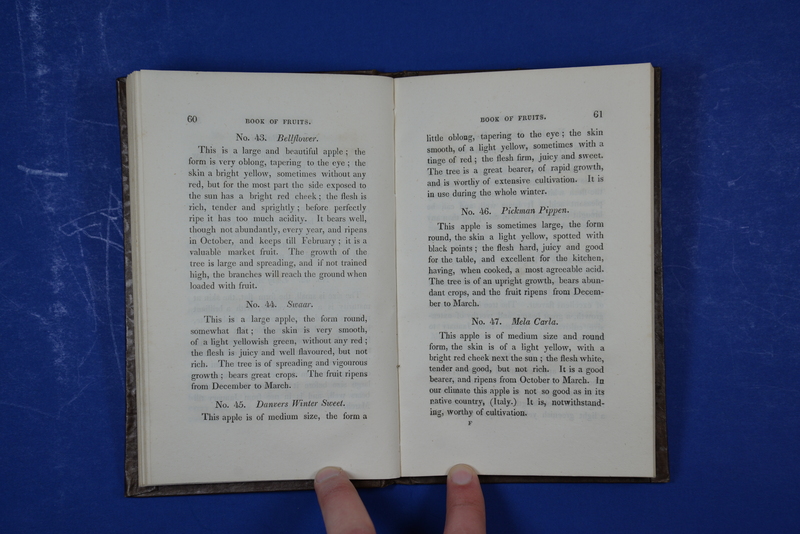 Book of Fruits, Being a Descriptive Catalogue of the Most Valuable Varieties Not just animals face extinction. Humans have driven an estimated 600 plant species to extinction since the 1750s, along with thousands of locally cultivated varieties of staple food crops, from potatoes to apples. Once-popular New England apple varieties like the Pickman Pippen (see above) have since disappeared as higher-yielding and aesthetically uniform apple varieties used in industrial agriculture have come into favor. Scientists now express concern about our reliance on an ever-smaller number of plant varieties cultivated for human consumption, as this leaves large portions of our food supply vulnerable to be wiped out by a singular disease or pest, like during the Irish Potato Famine in the 1840s.
Book of Fruits, Being a Descriptive Catalogue of the Most Valuable Varieties Not just animals face extinction. Humans have driven an estimated 600 plant species to extinction since the 1750s, along with thousands of locally cultivated varieties of staple food crops, from potatoes to apples. Once-popular New England apple varieties like the Pickman Pippen (see above) have since disappeared as higher-yielding and aesthetically uniform apple varieties used in industrial agriculture have come into favor. Scientists now express concern about our reliance on an ever-smaller number of plant varieties cultivated for human consumption, as this leaves large portions of our food supply vulnerable to be wiped out by a singular disease or pest, like during the Irish Potato Famine in the 1840s. -
 Leander Owen, whaling logbook, September 15th, 1881. Leander Owen (1833-1911) was a ship captain and whaling master who travelled extensively through the Arctic during the peak of the Atlantic whaling fishery. Owen’s personal journal documents the first whaling trip ever made into the Arctic by a steam-powered vessel. The journal recounts the astonishing speed and efficiency with which sailors were killing Bowhead and North Atlantic right whales—both species that are endangered in their native habitats today. Each drawing of a whale’s tail in Owen’s journal denotes one animal successfully killed and “cut” (stripped of its blubber) within a given day.
Leander Owen, whaling logbook, September 15th, 1881. Leander Owen (1833-1911) was a ship captain and whaling master who travelled extensively through the Arctic during the peak of the Atlantic whaling fishery. Owen’s personal journal documents the first whaling trip ever made into the Arctic by a steam-powered vessel. The journal recounts the astonishing speed and efficiency with which sailors were killing Bowhead and North Atlantic right whales—both species that are endangered in their native habitats today. Each drawing of a whale’s tail in Owen’s journal denotes one animal successfully killed and “cut” (stripped of its blubber) within a given day. -
 An Act for the Further Encouragement of the Whale Fishery In hopes of encouraging more whaling expeditions around Greenland, British Parliament and King George II passed this Act. It provides for tax breaks and reduced costs for sailing supplies "on the condition that their firm purpose, and determined resolution... is to use the utmost endeavors of themselves and their ship's company to take whales, or other creatures living in the sea... and to import whales fins, oil, and blubber thereof into the Kingdom of Great Britain.” The Act was instituted out of fears that Great Britain was falling behind other European nations in its production of whale oil. In the race for economic dominance by imperialist powers such as Great Britain, such acts led to increased hunting pressure even as whale stocks began to decline.
An Act for the Further Encouragement of the Whale Fishery In hopes of encouraging more whaling expeditions around Greenland, British Parliament and King George II passed this Act. It provides for tax breaks and reduced costs for sailing supplies "on the condition that their firm purpose, and determined resolution... is to use the utmost endeavors of themselves and their ship's company to take whales, or other creatures living in the sea... and to import whales fins, oil, and blubber thereof into the Kingdom of Great Britain.” The Act was instituted out of fears that Great Britain was falling behind other European nations in its production of whale oil. In the race for economic dominance by imperialist powers such as Great Britain, such acts led to increased hunting pressure even as whale stocks began to decline. -
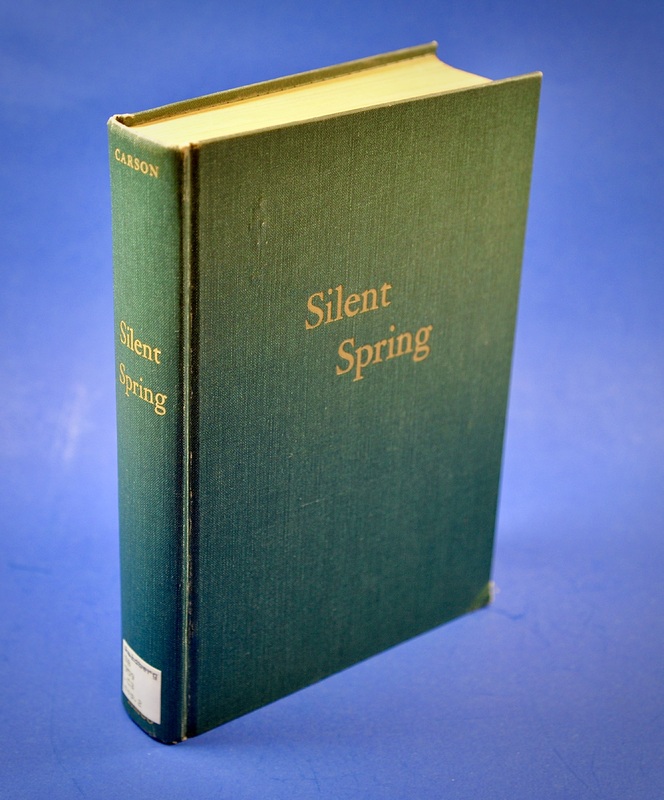 Silent Spring After the publication of Rachel Carson’s Silent Spring in 1962, the American public began to question their use of modern synthetic pesticides, such as dichloro-diphenyl-trichloroethane, or DDT. In the 30 years prior to being banned in 1972, a total of 1,350,000,000 pounds of DDT was sprayed across the United States. Carson reported that birds ingesting DDT tended to lay thin-shelled eggs that would break prematurely, resulting in population declines of more than 80 percent. Despite fierce opposition from chemical companies, Silent Spring ushered along numerous changes, including a reversal in United States pesticide policy, a nationwide ban on DDT in agriculture, and the eventual establishment of the Environmental Protection Agency by those inspired by the text. The book condoned short-sighted tampering with the environment that was pervasive during the Cold War, challenging farmers, companies, and the U.S. government to consider the long-term side effects of their actions. Without Silent Spring, the ban on DDT and ensuing protections, the bald eagle and dozens of other bird species would have likely disappeared from the continental U.S.
Silent Spring After the publication of Rachel Carson’s Silent Spring in 1962, the American public began to question their use of modern synthetic pesticides, such as dichloro-diphenyl-trichloroethane, or DDT. In the 30 years prior to being banned in 1972, a total of 1,350,000,000 pounds of DDT was sprayed across the United States. Carson reported that birds ingesting DDT tended to lay thin-shelled eggs that would break prematurely, resulting in population declines of more than 80 percent. Despite fierce opposition from chemical companies, Silent Spring ushered along numerous changes, including a reversal in United States pesticide policy, a nationwide ban on DDT in agriculture, and the eventual establishment of the Environmental Protection Agency by those inspired by the text. The book condoned short-sighted tampering with the environment that was pervasive during the Cold War, challenging farmers, companies, and the U.S. government to consider the long-term side effects of their actions. Without Silent Spring, the ban on DDT and ensuing protections, the bald eagle and dozens of other bird species would have likely disappeared from the continental U.S. -
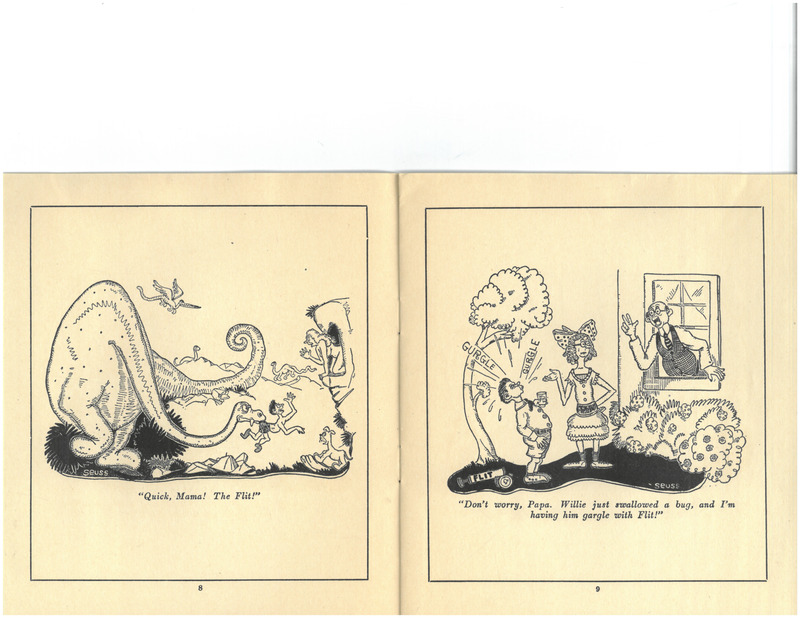 Flit insecticide cartoons, 1929 Long before his success as Dr. Seuss, Theodore Geisel (Dartmouth Class of 1925), designed advertisements for Flit, Standard Oil Company’s wildly popular spray-pump insecticide which later contained DDT. Over the course of 17 years, Geisel’s humorous advertisements helped make Flit a household name throughout the 1930s and 1940s. At the time, liberal spraying of pesticides around people, animals, and crops was highly encouraged with little regard to potential environmental impacts.
Flit insecticide cartoons, 1929 Long before his success as Dr. Seuss, Theodore Geisel (Dartmouth Class of 1925), designed advertisements for Flit, Standard Oil Company’s wildly popular spray-pump insecticide which later contained DDT. Over the course of 17 years, Geisel’s humorous advertisements helped make Flit a household name throughout the 1930s and 1940s. At the time, liberal spraying of pesticides around people, animals, and crops was highly encouraged with little regard to potential environmental impacts. -
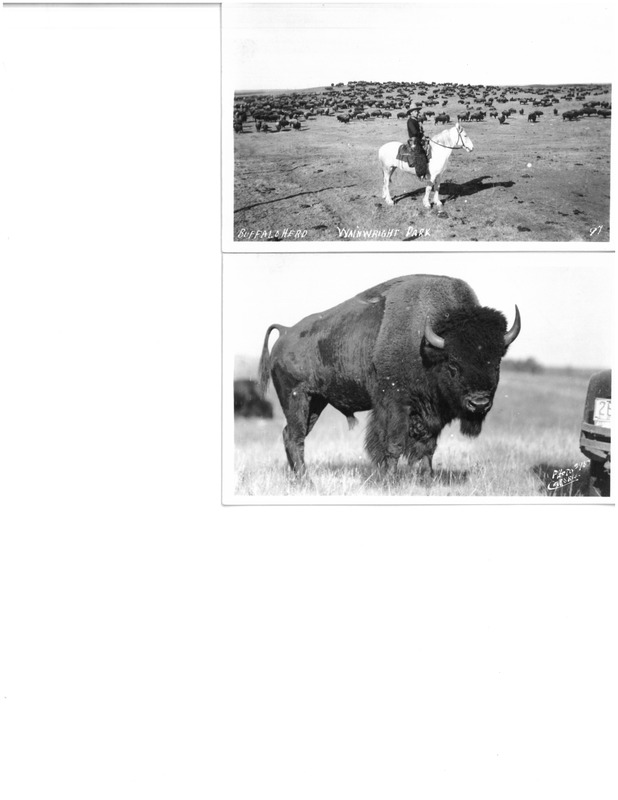 Photographs of plains bison in Wainwright Park, 1920-1921 Herds of bison roamed what is now Banff National Park in Alberta, Canada for 10,000 years until nearly driven to extinction by human activity prior to the park's creation in 1885. These photographs depict herds of plains bison in Wainwright Buffalo Park, Canada, established in 1909 to regenerate dangerously low populations of bison (and to produce beef as the photo captions indicate). In December of 2019, Parks Canada announced the release of a small herd of plains bison in Banff, over 140 years after local populations were hunted to extinction.
Photographs of plains bison in Wainwright Park, 1920-1921 Herds of bison roamed what is now Banff National Park in Alberta, Canada for 10,000 years until nearly driven to extinction by human activity prior to the park's creation in 1885. These photographs depict herds of plains bison in Wainwright Buffalo Park, Canada, established in 1909 to regenerate dangerously low populations of bison (and to produce beef as the photo captions indicate). In December of 2019, Parks Canada announced the release of a small herd of plains bison in Banff, over 140 years after local populations were hunted to extinction. -
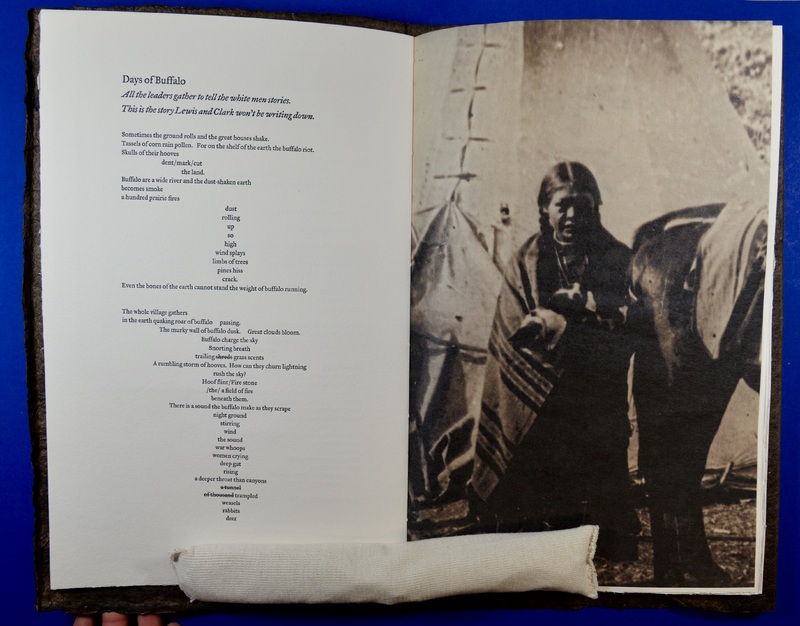 The Lost Journals of Sacajewea Debra Magpie Earling, a member of the Confederated Shalish and Kootenai Tribes of the Flathead Reservation, created this artist book during the bicentennial of the Lewis and Clark expedition to represent the hardships brought upon Native American cultures by colonialism. The cultural importance of the plains bison and the effects of its near extermination from the American West is reflected in both Earling’s poetry and the materials used to construct the book—it’s printed on smoked buffalo rawhide cover paper with trade beads and rifle shell cartridges adorning the spine. Earling writes, “Only a few photographs document the extermination of the bison and the hunter’s struggles against starvation. Instead, as if to marginalize the dying cultures, countless images survive that depict the arrival of the mining spectator, soldier, cowboy… all that followed to give us a thorough and close-up look at the noble savage-free territory of post-bison civilization.”
The Lost Journals of Sacajewea Debra Magpie Earling, a member of the Confederated Shalish and Kootenai Tribes of the Flathead Reservation, created this artist book during the bicentennial of the Lewis and Clark expedition to represent the hardships brought upon Native American cultures by colonialism. The cultural importance of the plains bison and the effects of its near extermination from the American West is reflected in both Earling’s poetry and the materials used to construct the book—it’s printed on smoked buffalo rawhide cover paper with trade beads and rifle shell cartridges adorning the spine. Earling writes, “Only a few photographs document the extermination of the bison and the hunter’s struggles against starvation. Instead, as if to marginalize the dying cultures, countless images survive that depict the arrival of the mining spectator, soldier, cowboy… all that followed to give us a thorough and close-up look at the noble savage-free territory of post-bison civilization.” -
 Inupiaq polar bear ivory carvings, circa 1960 These walrus ivory carvings owned by Alex Magtoya were produced by native Inupiat people of the Arctic Ocean and Bering Sea regions. Indigenous communities of the Arctic have hunted walrus (among other sea mammals including seals and whales) as sources of food for hundreds of years, utilizing their skins, bones, and tusks for clothing, tools, and crafts. Walrus populations plummeted around the Arctic by the early 20th-century following the arrival of Europeans, only to rebound when limits were placed on commercial hunts. Today, walruses, polar bears, and many other Arctic animals face an even-deadlier threat - global climate change.
Inupiaq polar bear ivory carvings, circa 1960 These walrus ivory carvings owned by Alex Magtoya were produced by native Inupiat people of the Arctic Ocean and Bering Sea regions. Indigenous communities of the Arctic have hunted walrus (among other sea mammals including seals and whales) as sources of food for hundreds of years, utilizing their skins, bones, and tusks for clothing, tools, and crafts. Walrus populations plummeted around the Arctic by the early 20th-century following the arrival of Europeans, only to rebound when limits were placed on commercial hunts. Today, walruses, polar bears, and many other Arctic animals face an even-deadlier threat - global climate change.

